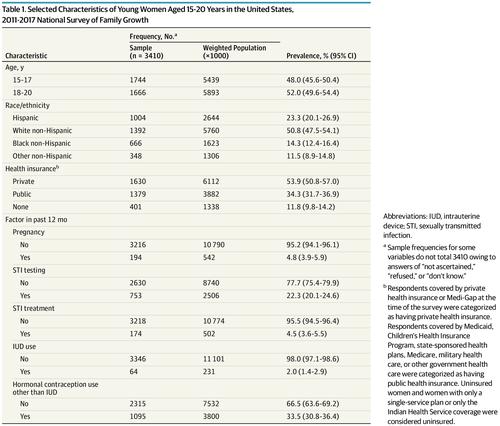当前位置:
X-MOL 学术
›
JAMA Intern. Med.
›
论文详情
Our official English website, www.x-mol.net, welcomes your
feedback! (Note: you will need to create a separate account there.)
Prevalence of Potentially Unnecessary Bimanual Pelvic Examinations and Papanicolaou Tests Among Adolescent Girls and Young Women Aged 15-20 Years in the United States
JAMA Internal Medicine ( IF 22.5 ) Pub Date : 2020-02-01 , DOI: 10.1001/jamainternmed.2019.5727 Jin Qin 1 , Mona Saraiya 1 , Gladys Martinez 2 , George F Sawaya 3, 4
JAMA Internal Medicine ( IF 22.5 ) Pub Date : 2020-02-01 , DOI: 10.1001/jamainternmed.2019.5727 Jin Qin 1 , Mona Saraiya 1 , Gladys Martinez 2 , George F Sawaya 3, 4
Affiliation

|
Importance
Pelvic examination is no longer recommended for asymptomatic, nonpregnant women and may cause harms such as false-positive test results, overdiagnosis, anxiety, and unnecessary costs. The bimanual pelvic examination (BPE) is an invasive and controversial examination component. Cervical cancer screening is not recommended for women younger than 21 years. Objectives
To estimate prevalence of potentially unnecessary BPE and Papanicolaou (Pap) tests performed among adolescent girls and women younger than 21 years (hereinafter referred to as young women) in the United States and to identify factors associated with receiving these examinations. Design, Setting, and Participants
A cross-sectional analysis of the National Survey of Family Growth from September 2011 through September 2017 focused on a population-based sample of young women aged 15 to 20 years (n = 3410). The analysis used survey weights to estimate prevalence and the number of people represented in the US population. Data were analyzed from December 21, 2018, through September 3, 2019. Main Outcomes and Measures
Receipt of a BPE or a Pap test in the last 12 months and the proportion of potentially unnecessary examinations and tests. Results
Responses from 3410 young women aged 15 to 20 years were included in the analysis with 6-year sampling weights applied. Among US young women aged 15 to 20 years represented during the 2011-2017 study period, 4.8% (95% CI, 3.9%-5.9%) were pregnant, 22.3% (95% CI, 20.1%-24.6%) had undergone STI testing, and 4.5% (95% CI, 3.6%-5.5%) received treatment or medication for an STI in the past 12 months (Table 1). Only 2.0% (95% CI, 1.4%-2.9%) reported using an IUD, and 33.5% (95% CI, 30.8%-36.4%) used at least 1 other type of hormonal contraception in the past 12 months. Among US young women aged 15 to 20 years who were surveyed in the years 2011 through 2017, approximately 2.6 million (22.9%; 95% CI, 20.7%-25.3%) reported having received a BPE in the last 12 months. Approximately half of these examinations (54.4%; 95% CI, 48.8%-59.9%) were potentially unnecessary, representing an estimated 1.4 million individuals. Receipt of a BPE was associated with having a Pap test (adjusted prevalence ratio [aPR], 7.12; 95% CI, 5.56-9.12), testing for sexually transmitted infections (aPR, 1.60; 95% CI, 1.34-1.90), and using hormonal contraception other than an intrauterine device (aPR, 1.31; 95% CI, 1.11-1.54). In addition, an estimated 2.2 million young women (19.2%; 95% CI, 17.2%-21.4%) reported having received a Pap test in the past 12 months, and 71.9% (95% CI, 66.0%-77.1%) of these tests were potentially unnecessary. Conclusions and Relevance
This analysis found that more than half of BPEs and almost three-quarters of Pap tests performed among young women aged 15 to 20 years during the years 2011 through 2017 were potentially unnecessary, exposing women to preventable harms. The results suggest that compliance with the current professional guidelines regarding the appropriate use of these examinations and tests may be lacking.
中文翻译:

在美国 15-20 岁的少女和年轻女性中可能不必要的双手盆腔检查和巴氏试验的流行
重要性 不再建议无症状、未怀孕的妇女进行盆腔检查,这可能会造成诸如假阳性检测结果、过度诊断、焦虑和不必要的费用等危害。双手盆腔检查 (BPE) 是一种侵入性和有争议的检查组件。不建议 21 岁以下的女性进行宫颈癌筛查。目的 评估在美国青春期少女和 21 岁以下女性(以下简称年轻女性)中进行的潜在不必要的 BPE 和巴氏 (Pap) 检测的患病率,并确定与接受这些检测相关的因素。设计,设置,和参与者 对 2011 年 9 月至 2017 年 9 月的全国家庭增长调查的横断面分析侧重于 15 至 20 岁年轻女性(n = 3410)的人口样本。该分析使用调查权重来估计美国人口中的流行率和人数。数据分析时间为 2018 年 12 月 21 日至 2019 年 9 月 3 日。 主要结果和措施 过去 12 个月内 BPE 或巴氏试验的接收情况以及可能不必要的检查和测试的比例。结果 3410 名年龄在 15 至 20 岁之间的年轻女性的回答被纳入分析,并采用了 6 年抽样权重。在 2011-2017 年研究期间代表的 15 至 20 岁美国年轻女性中,4.8%(95% CI,3.9%-5.9%)怀孕,22.3%(95% CI,20.1%-24.6%)经历过性传播感染测试,4.5% (95% CI, 3.6%-5.5%) 在过去 12 个月内接受过 STI 治疗或药物治疗(表 1)。只有 2.0% (95% CI, 1.4%-2.9%) 报告使用了宫内节育器,33.5% (95% CI, 30.8%-36.4%) 在过去 12 个月内使用了至少一种其他类型的激素避孕。在 2011 年至 2017 年接受调查的 15 至 20 岁美国年轻女性中,约有 260 万(22.9%;95% CI,20.7%-25.3%)报告在过去 12 个月内接受过 BPE。这些检查中约有一半(54.4%;95% CI,48.8%-59.9%)可能是不必要的,估计代表 140 万人。接受 BPE 与接受巴氏试验(调整后患病率 [aPR],7.12;95% CI,5.56-9.12),性传播感染检测(aPR,1.60;95% CI,1.34-1.90)相关,使用宫内节育器以外的激素避孕(aPR,1.31;95% CI,1.11-1.54)。此外,估计有 220 万年轻女性(19.2%;95% CI,17.2%-21.4%)报告在过去 12 个月内接受过巴氏试验,71.9%(95% CI,66.0%-77.1%)这些测试可能是不必要的。结论和相关性 该分析发现,在 2011 年至 2017 年期间,在 15 至 20 岁的年轻女性中进行的一半以上的 BPE 和近四分之三的巴氏涂片检查可能是不必要的,使女性暴露在可预防的伤害之下。结果表明,可能缺乏对有关适当使用这些检查和测试的当前专业指南的遵守。4%) 报告在过去 12 个月内接受过巴氏试验,其中 71.9% (95% CI, 66.0%-77.1%) 可能是不必要的。结论和相关性 该分析发现,在 2011 年至 2017 年期间,在 15 至 20 岁的年轻女性中进行的一半以上的 BPE 和近四分之三的巴氏涂片检查可能是不必要的,使女性暴露在可预防的伤害之下。结果表明,可能缺乏对有关适当使用这些检查和测试的当前专业指南的遵守。4%) 报告在过去 12 个月内接受过巴氏试验,其中 71.9% (95% CI, 66.0%-77.1%) 可能是不必要的。结论和相关性 该分析发现,在 2011 年至 2017 年期间,在 15 至 20 岁的年轻女性中进行的一半以上的 BPE 和近四分之三的巴氏涂片检查可能是不必要的,使女性暴露在可预防的伤害之下。结果表明,可能缺乏对有关适当使用这些检查和测试的当前专业指南的遵守。结论和相关性 该分析发现,在 2011 年至 2017 年期间,在 15 至 20 岁的年轻女性中进行的一半以上的 BPE 和近四分之三的巴氏涂片检查可能是不必要的,使女性暴露在可预防的伤害之下。结果表明,可能缺乏对有关适当使用这些检查和测试的当前专业指南的遵守。结论和相关性 该分析发现,在 2011 年至 2017 年期间,在 15 至 20 岁的年轻女性中进行的一半以上的 BPE 和近四分之三的巴氏涂片检查可能是不必要的,使女性暴露在可预防的伤害之下。结果表明,可能缺乏对有关适当使用这些检查和测试的当前专业指南的遵守。
更新日期:2020-02-01
中文翻译:

在美国 15-20 岁的少女和年轻女性中可能不必要的双手盆腔检查和巴氏试验的流行
重要性 不再建议无症状、未怀孕的妇女进行盆腔检查,这可能会造成诸如假阳性检测结果、过度诊断、焦虑和不必要的费用等危害。双手盆腔检查 (BPE) 是一种侵入性和有争议的检查组件。不建议 21 岁以下的女性进行宫颈癌筛查。目的 评估在美国青春期少女和 21 岁以下女性(以下简称年轻女性)中进行的潜在不必要的 BPE 和巴氏 (Pap) 检测的患病率,并确定与接受这些检测相关的因素。设计,设置,和参与者 对 2011 年 9 月至 2017 年 9 月的全国家庭增长调查的横断面分析侧重于 15 至 20 岁年轻女性(n = 3410)的人口样本。该分析使用调查权重来估计美国人口中的流行率和人数。数据分析时间为 2018 年 12 月 21 日至 2019 年 9 月 3 日。 主要结果和措施 过去 12 个月内 BPE 或巴氏试验的接收情况以及可能不必要的检查和测试的比例。结果 3410 名年龄在 15 至 20 岁之间的年轻女性的回答被纳入分析,并采用了 6 年抽样权重。在 2011-2017 年研究期间代表的 15 至 20 岁美国年轻女性中,4.8%(95% CI,3.9%-5.9%)怀孕,22.3%(95% CI,20.1%-24.6%)经历过性传播感染测试,4.5% (95% CI, 3.6%-5.5%) 在过去 12 个月内接受过 STI 治疗或药物治疗(表 1)。只有 2.0% (95% CI, 1.4%-2.9%) 报告使用了宫内节育器,33.5% (95% CI, 30.8%-36.4%) 在过去 12 个月内使用了至少一种其他类型的激素避孕。在 2011 年至 2017 年接受调查的 15 至 20 岁美国年轻女性中,约有 260 万(22.9%;95% CI,20.7%-25.3%)报告在过去 12 个月内接受过 BPE。这些检查中约有一半(54.4%;95% CI,48.8%-59.9%)可能是不必要的,估计代表 140 万人。接受 BPE 与接受巴氏试验(调整后患病率 [aPR],7.12;95% CI,5.56-9.12),性传播感染检测(aPR,1.60;95% CI,1.34-1.90)相关,使用宫内节育器以外的激素避孕(aPR,1.31;95% CI,1.11-1.54)。此外,估计有 220 万年轻女性(19.2%;95% CI,17.2%-21.4%)报告在过去 12 个月内接受过巴氏试验,71.9%(95% CI,66.0%-77.1%)这些测试可能是不必要的。结论和相关性 该分析发现,在 2011 年至 2017 年期间,在 15 至 20 岁的年轻女性中进行的一半以上的 BPE 和近四分之三的巴氏涂片检查可能是不必要的,使女性暴露在可预防的伤害之下。结果表明,可能缺乏对有关适当使用这些检查和测试的当前专业指南的遵守。4%) 报告在过去 12 个月内接受过巴氏试验,其中 71.9% (95% CI, 66.0%-77.1%) 可能是不必要的。结论和相关性 该分析发现,在 2011 年至 2017 年期间,在 15 至 20 岁的年轻女性中进行的一半以上的 BPE 和近四分之三的巴氏涂片检查可能是不必要的,使女性暴露在可预防的伤害之下。结果表明,可能缺乏对有关适当使用这些检查和测试的当前专业指南的遵守。4%) 报告在过去 12 个月内接受过巴氏试验,其中 71.9% (95% CI, 66.0%-77.1%) 可能是不必要的。结论和相关性 该分析发现,在 2011 年至 2017 年期间,在 15 至 20 岁的年轻女性中进行的一半以上的 BPE 和近四分之三的巴氏涂片检查可能是不必要的,使女性暴露在可预防的伤害之下。结果表明,可能缺乏对有关适当使用这些检查和测试的当前专业指南的遵守。结论和相关性 该分析发现,在 2011 年至 2017 年期间,在 15 至 20 岁的年轻女性中进行的一半以上的 BPE 和近四分之三的巴氏涂片检查可能是不必要的,使女性暴露在可预防的伤害之下。结果表明,可能缺乏对有关适当使用这些检查和测试的当前专业指南的遵守。结论和相关性 该分析发现,在 2011 年至 2017 年期间,在 15 至 20 岁的年轻女性中进行的一半以上的 BPE 和近四分之三的巴氏涂片检查可能是不必要的,使女性暴露在可预防的伤害之下。结果表明,可能缺乏对有关适当使用这些检查和测试的当前专业指南的遵守。











































 京公网安备 11010802027423号
京公网安备 11010802027423号